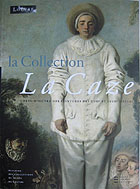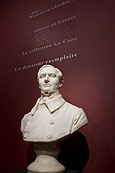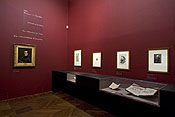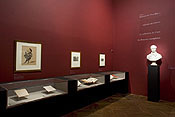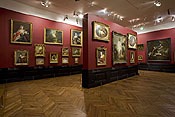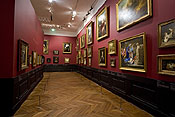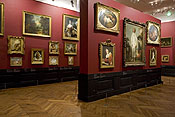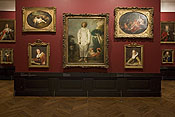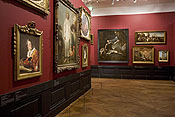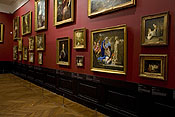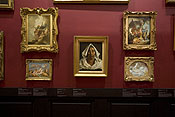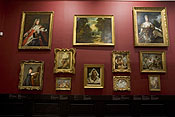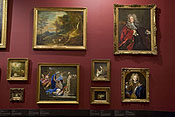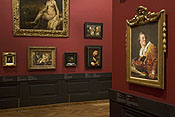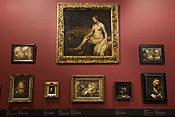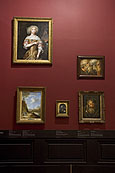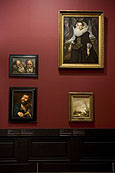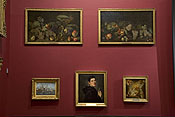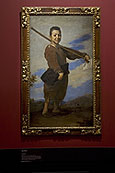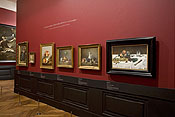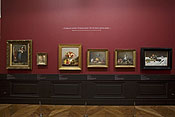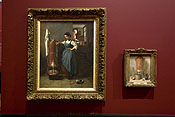The browser will either open the file, download it, or display a dialog.
|
La Collection La Caze: chefs d'œuvre des peintures des XVIIe et XVIIIe siècles |
|||
| When Emperor Napoléon III and Empress Eugénie made a special visit to the Louvre on March 14, 1870, they witnessed the museum's most important donation of the Second Empire within six months of its fall. The gift of 583 paintings (275 exhibited) from Paris-based collector Dr. Louis La Caze (1798-1869) enriched France's principal historical museum with works that remain among the collection's most important, including: Watteau's Pierrot (Gilles) , Ribera's Club-Footed Boy, Hals's Gypsy Girl, Rembrandt's Bathsheba with King David's Letter (1654), Fragonard's Abbott of Saint-Non (1769), and Chardin's Grace to name a few. Comte de Nieuwerkerke, Surintendent des Beaux-Arts (1863-70), and Maréchal Vaillant, Minister of Fine-Arts (1863-70), accompanied Napoléon III and Eugénie as they admired the collection installed in the largest room of the musée Napoléon III section of the Louvre, where the Campana collection was previously displayed. | ||||
| La Collection La Caze: chefs d'œuvre des peintures des XVIIe et XVIIIe siècles, recently published under the direction of Guillaume Faroult, Curator in the Department of Paintings, with the collaboration of Sophie Eloy, provides a significant addition to the growing scholarship on the important subject of collecting in Second Empire France. Françoise Maison's catalogue Le comte de Nieuwerkerke and exhibition at the château de Compiègne in 2000 offered an important precedent.1 Catherine Granger's L'Empereur et les arts. La liste civile de Napoléon III published in 2005 also provides a notable contribution to the study of collecting in France 1852-1870.2 | ||||
| The La Caze book appears at the same time as the impressive exhibition 1869: Watteau et Chardin… entrent au Louvre. La collection La Caze reenacts the collection's original display on a much-reduced scale. The exhibition opened at the Louvre (26 April-9 Jul 2007) and travels to the Musée des Beaux-Arts in Pau (20 September-10 December 2007) where the La Caze family originated. It then travels to London, where it will be seen at the Wallace Collection (14 February-18 May 2008), created by La Caze's contemporary Richard Seymour-Conway, fourth marquis of Hertford. | ||||
| The introductory section to La Collection La Caze includes remarks from the current director of the Louvre Henri Loyrette, the previous director Pierre Rosenberg, as well as chief curator Vincent Pomarède, the book's lead author Guillaume Faroult, and Sylvie Béguin, all of the Louvre's department of painting. Loyrette identifies La Caze as the most generous of all of the Louvre's donors in the area of historical painting. Of La Caze's original donation of 583 paintings, which constituted his entire art collection at the time of his death in 1869, approximately one-third of the works remain at the Louvre. The rest have been dispersed among regional museums, as well as ministerial and ambassadorial offices. Béguin's "L' 'Hommage à Louis La Caze' de 1869" summarizes the intent of the eponymous exhibition she curated with the assistance of Claire Constans. Prior to the current exhibition, it served as the leading tribute to the La Caze donation. Although there was no accompanying catalogue with in-depth research as the current publication offers, the curators published an important article in Revue du Louvre.3 The following sections of the book present first contextual, and second geographic, approaches to studying the collection. An accompanying CD-rom includes a complete catalogue. | ||||
| Section I: Louis La Caze, Un Portrait Impossible includes thirteen essays by nine different authors whose work demonstrates how La Caze and his collection provide a rich scope through which to study the history of the Louvre, and to view the art market, revivals and artistic practices during the Second Empire, as well as the doctor's interesting biography. | ||||
| When La Caze decided to bequeath his collection to the "Musée de Paris" (as the Louvre was then known), he compiled a hand-written inventory on July 24, 1865 and offered his then 455 paintings. Before his death on September 28, 1869, La Caze collected at a feverish pace and acquired over one hundred additional works. The terms in which La Caze offered his collection were so open and unrestricted as to be welcome by any director today. While he offered his entire collection to the Louvre, La Caze authorized that any works the museum did not want to accept could be distributed among France's provincial museums ("S'il en est que le Musée ne veuille pas accepter, je le prie de les distributer à plusieurs musées de province)4 (156). Such terms positioned Nieuwerkerke well when he announced the donation at a curatorial meeting on October 11, 1869. As Elisabeth Foucart-Walter notes, Nieuwerkerke could defend the donation to any who criticized some of the less significant works in the collection. The cataloguing and accessioning of works structured the hierarchical approach that ultimately left 275 paintings at the Louvre from the total gift of 583. The remaining works were sent to the provinces only in 1872 after the Franco-Prussian war and Commune, when they joined more than 1,000 works sent from the Louvre to 118 different museums. Each provincial museum was given an average of between one and four works, except for Pau, which received twenty-nine paintings because of the La Caze family origins in that city. | ||||
| La Caze also noted in his will that he hoped the Louvre would dedicate a room to the display of his works ("J'ai l'espoir qu'on voudra bien leur consacrer une salle"), although this was not a restriction he placed on his donation. On March 15, 1870 when the collection opened to the public in the former salle des séances (currently antique bronzes), the display fulfilled La Caze's wish. This large room on the west side of the cour carré was then positioned at the beginning of the painting galleries and the presentation of canvases four rows deep offered a dense environment that mixed works from different centuries and countries. This provided quite a different experience from the separation into schools and periods of the chronological display found in the rest of the museum. | ||||
| This presentation, organized by curator Frédéric Reiset, also offered something of the experience of La Caze's home environment. As a close friend, Reiset was well familiar with the famously dense ten-row-deep display at La Caze's home at 116 rue du Cherche-Midi. When François Marcille took Edmond and Jules de Goncourt to see La Caze's home in May 1859, the famous literary brothers criticized his display as an eclectic and unworthy way of displaying a collection. Pierre Rosenberg successfully diminishes the emphasis that has been placed on the Goncourt brothers' views, although it reappears later in the text without the same revisionist perspective. (19, 86) La Caze developed his innovative display after 1853 when he moved from rue Neuve-des-Mathurins to a large home on rue du Cherche-Midi, an event that also ignited the significant increase of his purchases in the 1850s. Carole Blumenfeld argues that La Caze began collecting in his 20s, likely at the shops in the Saint-Jacques quarter, and was around twenty-six when he bought his first work at a public sale. Guillaume Faroult believes critic Philippe Burty's report that La Caze's first purchase was a work by Chardin bought on the banks of the Seine in 1825 for fifteen francs, although it cannot be confirmed. | ||||
| Marie-Martine Dubrueil offers a comprehensive explanation of how La Caze built his collection and she had arguably the most difficult task of any contributor. Dubreuil's extensive work with auction catalogues gives evidence of one quarter of La Caze's works originating in auction sales. She proposes his first auction purchase as Chardin's House of Cards at the Langlier sale at the end of 1832. From his early years of more modest collecting and reselling of works, La Caze bought three times as many works in the 1840s and was active at the prestigious sales of the Aguado, Fesch, Solirène and Cypierre collections. La Caze did not restrict himself to Paris-based sales, but also looked to the French provinces and was well connected even to foreign dealers in London and Brussels. He often bought from the collections of artists at estate sales and was attentive to the provenance of his acquisitions. La Caze acquired works that were formerly in the collections of the marquis de Marigny, Robert de Saint-Victor, comte de Robiano, and unidentified royal residences emptied during the Revolution of 1789. | ||||
| Watteau's Gilles (a creative off-center display of which adorns the cover of this well-designed book) is likely the most famous work in La Caze's collection and he bought it surprisingly early, in 1838 from the marquis de Cypierre's collection. There is evidence that he acquired Ribera's Club-footed boy the following year for 300 francs. La Caze likely bought Rembrandt's Bathsheba with King David's letter in 1848 directly from the son of Casimir Perier before the rest of the collection sold in London May 5, 1848. With these and other astute purchases, Dubrueil presents La Caze as a passionate collector who patiently researched his works and acquired pieces discretely from public sales. | ||||
| In 1860 La Caze's collection became well known publicly when he contributed fifty-three works to an exhibition organized by the Martinet Gallery, the history of which is detailed in an excellent essay by Guillaume Faroult. Louis Martinet opened the gallery in 1859 and dedicated the first exhibitions to Ary Scheffer (d.1858) and a presentation of "modern paintings". From July 10 to December 25, 1860 Martinet worked with dealer and expert Francis Petit and critic Burty who collaborated to organize an exhibition of historical French painting for the benefit of the "caisse de secours des artistes peintres, sculpteurs, architectes et dessinateurs." In their choice of works, Petit and Burty were undoubtedly inspired by the poor representation of French painting at the "Art Treasures of the United Kingdom" exhibition held in Manchester in 1857, which drew an incomparable total of 1,300,000 visitors from across Europe. While little is known of the hanging of works or the number of visitors to the Martinet gallery exhibition of 1860, its emphasis on eighteenth-century French painting was informed by publication of the first fascicles of L'Art du XVIII by the Goncourt brothers. Prud'hon was the most represented artist at the exhibition (fifty-five paintings and drawings; and interestingly an artist entirely absent from La Caze's collection), followed closely by Chardin (forty-five) and Fragonard, while Watteau was the artist whom critics cited most frequently. La Caze loaned more works to this exhibition than any other collector and additions to the catalogue reveal how he continued to offer more works during the course of the five-and-a-half months of the exhibition. Faroult argues that the significant critical and public success of this exhibition assured the triumph of eighteenth-century French art and even influenced public institutions. The example cited of about the acquisition of three of Chardin's works by the Louvre in 1867 seems, however, a surprisingly delayed outcome. | ||||
| The Martinet gallery exhibition of 1860 was displayed in the interesting venue of three rooms "dans le jardin," on the main floor of Lord Hertford's home on boulevard des Italiens at the corner of rue Lafitte, in one of the most elegant areas of the city. Lord Hertford's incomparable collection, which later formed the Wallace Collection, is the subject of Jo Hedley's interesting study that helps to situate La Caze's collection in a broader context. While both men were comparable in age (La Caze was two years older), began their collections at approximately the same time, and displayed their acquisitions with comparably mixed presentations of schools and eras, similarities between the collections were necessarily limited. Hedley explains that La Caze did not have comparable financial means or the same level of networking agents and dealers, and even seems to have deferred to Hertford when they purchased works at the same public sales. Unlike La Caze who collected little contemporary art (the works by Bouchot, Dedreux-Dorcy, Géricault and Drolling were likely informed by friendships), Hertford was well known for his collection of modern French art, particularly academic painting of the romantic school such as Meissonier and Vernet. Both were avid collectors of Dutch and Flemish art following the tradition established during the ancien régime (Teniers, Dou, and Brouwer), but Hertford preferred landscape and hunting scenes that held greater ties to his social milieu. Most notably, the two men had diverging tastes for pictorial techniques. Hertford favored finished surfaces while La Caze's taste was for technical richness and virtuosity known as "la tartouille", a term that the book's contributors confusingly cite as having been in use in studios by 1773 (48) and, in another instance, as appearing in studios beginning in 1770 (198). The men's tastes diverged most notably with Chardin whose work Hedley argues did not appeal to Hertford's aristocratic tastes while La Caze acquired fifteen works by Chardin (two of which are now considered to be either after Chardin or by an imitator). | ||||
| Perhaps the most significant difference between Hertford and La Caze was not the size of their wealth and collections but the extent to which they opened their respective collections to visitors. While both made generous loans to exhibitions, Hertford's collection was otherwise closed to the pubic whereas La Caze received visitors on Sunday mornings and himself offered tours of his collection. In the words of Philippe Burty, "He loved artists. He let them copy anything they wanted to at his house" (129-130). As the essay by Sophie Eloy and Guillaume Faroult shows, artists including François Bonvin, Edgar Degas, Henri Fantin-Latour, Edouard Manet, and Princess Mathilde all executed copies in La Caze's home. Bonvin said that he went nearly every Sunday during the summer months and the authors believe it was likely Bonvin who introduced many other artists to the collection. The exhibition and book successfully convey the common practice of copying chez La Caze by juxtaposing Bonvin's Woman at the Cistern with Chardin's Copper Cistern (cat. figures 92, 94) and Manet's Brioche with Chardin's work of the same title (cat. figures 106, 107). | ||||
| Guillaume Faroult states La Caze represented a new type in society, particularly after his death, of "the collector". This term, which Faroult identifies as then new in the French language, he defines as distinct from an "amateur" (an aristocrat or financier) and is a bourgeois figure of more limited financial means who is also an artist or writer interested in objects for their historical value (143). The challenges of offering a coherent study that includes essays by so many different authors emerges around this proposed definition of a collector. In the following essay Sophie Eloy's section "From Collector to Amateur" argues that La Caze increasingly assumed the position of an "amateur" during the Second Empire when government officials regularly asked him for advice (151-152). The reader is left unsure of whether La Caze should be regarded as an important "amateur" or a new type of "collector", which were previously presented as mutually exclusive personas. | ||||
| La Caze regularly signed the roster of visitors at Nieuwerkerke's weekly gatherings and in 1855 he was nominated to the art admissions jury for the Universal Exposition. The two men were, however, never close, and when Nieuwerkerke visited La Caze's home in 1862 he surprisingly toured the collection without La Caze. From 1864 to his death in 1869 La Caze participated in the Salon jury and once commented on a work under consideration: "It is detestable, but one bad painting hardly matters in an exhibition, and it could mean a piece of bread for the poor devil who painted it" (155). Earlier in 1861 La Caze was part of a committee to review the conservation and restoration of art at the Louvre following a negative press campaign about work done under curator Frédéric Villot who resigned May 15, 1860. From 1861 to 1863 he was also a member of the short-lived acquisitions committee. | ||||
| La Caze was intimately familiar with the Louvre collection and Guillaume Faroult argues convincingly that it was in his youth that La Caze's tastes diverged from the canon of art history presented by institutions (he also traveled outside France to Germany [1858], the Hague [1861], England [1857], and perhaps Italy). While we know nothing of La Caze's knowledge of art history, critics Charles Blanc, Théophile Gautier, Philippe Burty, Edmond and Jules de Goncourt and Théophile Thoré (William Bürger) were all familiar with his collection and Thoré on occasion advised La Caze on his acquisitions. The burgeoning art press in fact frames much of the development of La Caze's collection from the foundation of L'Artiste in 1831 to the beginning of the Gazette des Beaux-Arts in 1859. However, La Caze's own artistic training emerges as the most formative influence on the independent path he took in developing his private collection. | ||||
| Isabelle Hostein addresses the difficult question of whether La Caze was a student of Girodet or had "passed through Girodet's studio" (35). Two works by La Caze survive, a Self-Portrait (cat. figure 11) and Psyche, after Gérard (cat. figure 12), and he studied art while he was a medical student. If La Caze were a student of Girodet he would have been part of what scholars describe as the "second generation" (1816-1824) of Girodet students when the artist's training practices shifted from having students copy plaster casts and prints in the studio to directing them to study in museums. The beginning of Hostein's essays seems to attempt to deconstruct or at least scrutinize the myth of La Caze's presence in Girodet's studio, but then she concludes with the surprisingly myth-building statement that while La Caze's attachment to painting began in Girodet's studio, the development of his tastes was uniquely his own. | ||||
| After the thorough and interesting essays in the first section of the catalogue, the studies in the second section with their focus on national schools are less engaging. The comprehensively thorough catalogue entries on the accompanying CD-rom seem far more significant that the brief discussions of the French eighteenth century, Northern school, Italian baroque, Venetian sixteenth century, and Spanish and English sections of La Caze's collection. Indeed the very division of the collection into discrete national sections contradicts La Caze's original goals of a historically and geographically mixed display, what Guillaume Faroult describes as a "counter-museum" and Jacques Foucart previously asserted was intended to fill the lacunae of the Louvre (188, 25). | ||||
| The Louvre's exhibition of La Caze's works maintained his wishes until the works were increasingly incorporated into the rest of the permanent collection. This process began with the Dutch and Flemish works in 1900, the Spanish paintings in 1921, and continued with part of the French collection in 1936. The essays that focus on national schools each outline significant purchases and list notable changes in attribution, sometimes even between countries as is the case with the two works La Caze thought he owned by Gainsborough, that are now assigned to Jean-François de Troy. Jean Habert's conclusion that La Caze would have had greater success with the Venetian sixteenth-century portion of his collection (La Caze was wrong about ten of the eleven works he thought he owned by Tintoretto) if he had only spent more money seems unnecessarily reductive. | ||||
| The question of attribution emerges throughout the text, but is not fully addressed. Blaise Ducos is understandably uncritical of La Caze's acquisition of Rembrandt's Suzanna at the Bath (Musée du Louvre inventaire #958), which he argues shows the collector's taste for Rembrandt's style. Marie-Martine Dubreuil noted earlier in the text that La Caze bought this work in 1846 through the Alliance des arts, a commercial association founded by Thoré who presented the copy of Suzanna at the Bath as a variation on the original. La Caze was justifiably persuaded by both the work's signature and date (lower left: Rembrandt f. 1647) and his esteem for Thoré's reputation. But the reader is left uncertain as to how La Caze's selection of works relates to larger issues of authenticity and the growing market for art in nineteenth-century France. There appear to have been fewer changes in attribution among the numerous eighteenth-century French works La Caze acquired (although this is difficult to determine even after a close reading of the text). It is not clear, however, if this was the result of greater knowledge in this area on La Caze's part or that the eighteenth-century works were less subject to an inflationary market because demand was more recent. The archival research undertaken for this text was admirably in-depth and without being overly critical of the impressive final product, it is necessary to indicate the lack of a coherent analysis of the question of attribution as it pertains to La Caze's collection. | ||||
| When La Caze bequeathed his works to the Louvre and France's provincial museums, he offered a collection of 583 works, 275 of which remained at the Louvre and meant not only that French eighteenth-century painting was finally well represented at the country's leading museum, but that the national collection was significantly enriched with important Dutch, Flemish, Spanish, and Italian works. The estimated value of La Caze's donation in 1869 was 1.5 to 2 million francs, although Sophie Eloy suggests this figure was low. La Caze never married and, like Lord Hertford, referred to his paintings as his children. The breadth and quality of Lacaze's donation to the Louvre, along with the prizes he established at the École de Médicine de Paris and the Academy of Science, are the fruits of his life and demonstrate the passion, intelligence and generosity of one of the preeminent philanthropists in French history (see figs. 2-21 for images of the exhibition installation). | ||||
| Alison McQueen Associate Professor of Art History, McMaster University, Canada ajmcq[at]mcmaster.ca |
||||
|
1. Françoise Maison, Le comte de Nieuwerkerke: Art et pouvoir sous Napoléon III. Paris, RMN, 2000. 2. Catherine Granger, L'Empereur et les arts. La liste civile de Napoléon III. Paris: École des Chartres, 2005. 3. Sylvie Béguin and Claire Constans, "Hommage à Louis La Caze 1798-1869 au musée du Louvre," Revue du Louvre vol.2 (1969): 115-132. 4. All translations are by the author. |
||||
| © 2007–8 Nineteenth-Century Art Worldwide and Alison McQueen. All Rights Reserved. |


